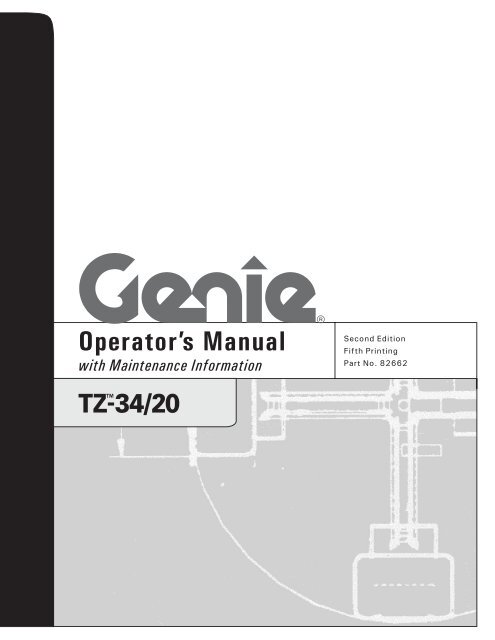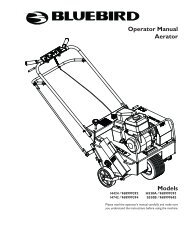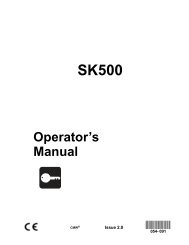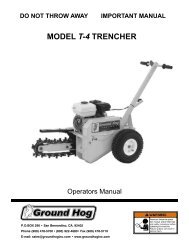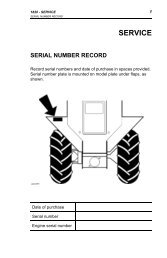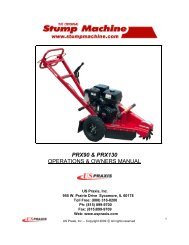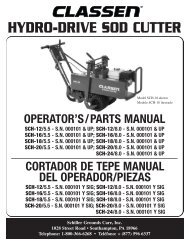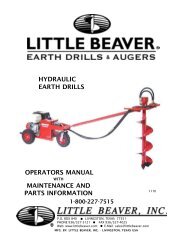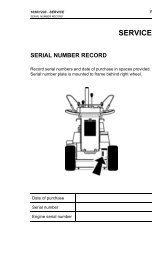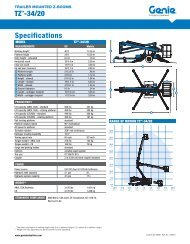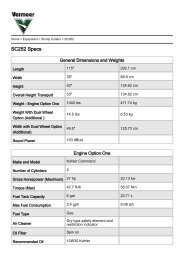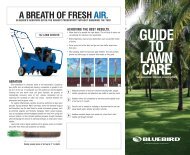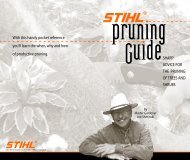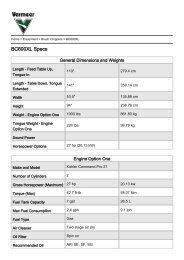Operator's Manual - Genie
Operator's Manual - Genie
Operator's Manual - Genie
Create successful ePaper yourself
Turn your PDF publications into a flip-book with our unique Google optimized e-Paper software.
Operator’s <strong>Manual</strong><br />
with Maintenance Information<br />
Second Edition<br />
Seventh Fifth Printing Printing<br />
Part No. 43645 82662
<strong>Operator's</strong> <strong>Manual</strong> Second Edition • Fifth Printing<br />
Important<br />
Read, understand and obey these safety rules and<br />
operating instructions before operating this machine.<br />
Only trained and authorized personnel shall be<br />
permitted to operate this machine. This manual should<br />
be considered a permanent part of your machine and<br />
should remain with the machine at all times. If you have<br />
any questions, call <strong>Genie</strong> Industries.<br />
Contents<br />
Page<br />
Safety ........................................................................ 1<br />
Controls ..................................................................... 8<br />
Pre-operation Inspection ........................................... 10<br />
Maintenance ............................................................. 12<br />
Function Tests .......................................................... 15<br />
Workplace Inspection ................................................ 20<br />
Operating Instructions ............................................... 21<br />
Transport and Lifting Instructions .............................. 26<br />
Decals ...................................................................... 28<br />
Specifications ........................................................... 32<br />
Reporting Safety Defects .......................................... 34<br />
Contact us:<br />
Internet: http://www.genielift.com<br />
e-mail: techpub@genieind.com<br />
Copyright © 2003 by <strong>Genie</strong> Industries<br />
First Edition: First Printing, April 2003<br />
Second Edition: Fifth Printing, February 2004<br />
"<strong>Genie</strong>" is a registered trademark of <strong>Genie</strong><br />
Industries in the USA and many other countries.<br />
These machines comply with<br />
ANSI/SIA 92.2-1990.<br />
Printed on recycled paper<br />
Printed in U.S.A.<br />
<strong>Genie</strong> TZ-34/20 Part No. 82662
Second Edition • Fifth Printing<br />
Danger<br />
<strong>Operator's</strong> <strong>Manual</strong><br />
Safety Rules<br />
Failure to obey the instructions and<br />
safety rules in this manual will<br />
result in death or serious injury.<br />
Do Not Operate Unless:<br />
You learn and practice the principles of safe<br />
machine operation contained in this operator's<br />
manual.<br />
1 Avoid hazardous situations.<br />
Know and understand the safety rules<br />
before going on to the next section.<br />
2 Always perform a pre-operation inspection.<br />
3 Always perform function tests prior to use.<br />
4 Inspect the workplace.<br />
5 Only use the machine as it was intended.<br />
You read, understand and obey the<br />
manufacturer's instructions and safety rules—<br />
safety and operator's manuals and machine<br />
decals<br />
You read, understand and obey employer's<br />
safety rules and worksite regulations<br />
You read, understand and obey all applicable<br />
governmental regulations<br />
You are properly trained to safely operate the<br />
machine.<br />
Part No. 82662 <strong>Genie</strong> TZ-34/20 1
<strong>Operator's</strong> <strong>Manual</strong> Second Edition Fifth Printing<br />
SAFETY RULES<br />
Electrocution Hazards<br />
This machine is not electrically insulated and will<br />
not provide protection from contact with or<br />
proximity to electrical current.<br />
Maintain safe distances from electrical power lines<br />
and apparatus in accordance with applicable<br />
governmental regulations and the following chart.<br />
Voltage Minimum Safe<br />
Phase to Phase Approach Distance<br />
Feet Meters<br />
0 to 300V Avoid Contact<br />
300V to 50KV 10 3.05<br />
50KV to 200KV 15 4.60<br />
200KV to 350KV 20 6.10<br />
350KV to 500KV 25 7.62<br />
500KV to 750KV 35 10.67<br />
750KV to 1000KV 45 13.72<br />
Allow for platform movement, electrical line sway or<br />
sag and beware of strong or gusty winds.<br />
Keep away from the machine if it contacts<br />
energized power lines. Personnel on the ground or<br />
in the platform must not touch or operate the<br />
machine until energized power lines are shut off.<br />
Do not operate the machine during lightning or<br />
storms.<br />
Do not use the machine as a ground for welding.<br />
Do not operate an AC powered machine or a DC<br />
battery charger unless using a 3-wire grounded<br />
extension cord connected to a grounded AC circuit.<br />
Do not alter or disable 3-wire grounded plugs.<br />
Tip-over Hazards<br />
Occupants, equipment and materials shall not<br />
exceed the maximum platform capacity.<br />
Maximum capacity - without optional platform rotate<br />
ANSI/CSA models - 2 occupants 500 lbs 227 kg<br />
CE models - 2 occupants 440 lbs 200 kg<br />
Maximum capacity - with optional platform rotate<br />
ANSI/CSA models - 2 occupants 460 lbs 209 kg<br />
CE models - 1 occupant 400 lbs 181 kg<br />
Do not raise the boom unless the machine is level.<br />
Do not set the machine up on a surface where it<br />
cannot be leveled using only the outriggers.<br />
Do not raise the boom unless all four outriggers are<br />
lowered, the footpads are in firm contact with the<br />
ground and the machine is level.<br />
Do not set the machine up unless it is on a firm<br />
surface. Avoid drop-offs, holes, unstable or<br />
slippery surfaces and other possible hazardous<br />
conditions.<br />
2 <strong>Genie</strong> TZ-34/20 Part No. 82662
Second Edition Fifth Printing<br />
Do not move the machine when the boom is raised.<br />
Do not adjust or stow the outriggers when the boom<br />
is raised.<br />
Do not depend on the tilt alarm as a level indicator.<br />
The tilt alarm sounds only when the machine is on<br />
a severe slope.<br />
When the tilt alarm sounds, immediately lower the<br />
boom and adjust the outriggers to level the<br />
machine.<br />
Do not alter or disable the limit switches.<br />
Do not operate the<br />
machine in strong or<br />
gusty winds. Do not<br />
increase the surface<br />
area of the platform or<br />
the load. Increasing<br />
the area exposed to<br />
the wind will decrease<br />
machine stability.<br />
Do not alter or disable machine components that in<br />
any way affect safety and stability.<br />
Do not replace items critical to machine stability<br />
with items of different weight or specification.<br />
Do not modify or alter an aerial work platform<br />
without prior written permission from the<br />
manufacturer. Mounting attachments for holding<br />
tools or other materials onto the platform, toeboards<br />
or guard rail system can increase the weight in the<br />
platform and the surface area of the platform or the<br />
load.<br />
Do not transport tools and materials unless they are<br />
evenly distributed and can be safely handled by<br />
person(s) in the platform.<br />
Do not place ladders or scaffolds in the platform or<br />
against any part of this machine.<br />
<strong>Operator's</strong> <strong>Manual</strong><br />
SAFETY RULES<br />
Do not use the machine on a moving or mobile<br />
surface or vehicle.<br />
Be sure all tires are properly inflated and in good<br />
condition and lug nuts are properly tightened.<br />
Do not use the platform as a crane.<br />
Do not place loads outside<br />
the platform perimeter.<br />
Do not place or attach<br />
overhanging loads to any<br />
part of the platform.<br />
Maximum allowable<br />
manual force, CE 400 N<br />
Do not push off or pull toward any object outside of<br />
the platform.<br />
Do not push the machine or other objects with the<br />
boom.<br />
Do not use the platform controls to free a platform<br />
that is caught, snagged or otherwise prevented<br />
from normal motion by an adjacent structure. All<br />
personnel must be removed from the platform<br />
before attempting to free the platform using the<br />
ground controls.<br />
DC models: Do not use batteries that weigh less<br />
than the original equipment. Four batteries are used<br />
as counterweight and are critical to machine<br />
stability. Each battery must weigh 65 pounds /<br />
29.5 kg.<br />
Do not contact adjacent structures with the boom.<br />
Do not tie the boom or platform to adjacent<br />
structures.<br />
Part No. 82662 <strong>Genie</strong> TZ-34/20 3
<strong>Operator's</strong> <strong>Manual</strong> Second Edition Fifth Printing<br />
SAFETY RULES<br />
Fall Hazards<br />
Occupants must wear a<br />
safety belt or harness<br />
and comply with<br />
applicable governmental<br />
regulations. Attach the<br />
lanyard to the anchor<br />
provided in the platform.<br />
Do not sit, stand or climb on the platform guard<br />
rails. Maintain a firm footing on the platform floor at<br />
all times.<br />
Do not climb down from the platform when raised.<br />
Keep the platform floor clear of debris.<br />
Lower the platform entry mid-rail or close the entry<br />
gate before operating.<br />
Collision Hazards<br />
The machine must be on a level surface or secured<br />
before releasing the parking brake.<br />
Use the parking brake to control the speed of the<br />
machine when pushing a machine that is not<br />
attached to a tow vehicle.<br />
Check the work area for overhead obstructions or<br />
other possible hazards.<br />
Be aware of crushing hazards when grasping the<br />
platform guard rail.<br />
Do not lower the boom unless the area below is<br />
clear of personnel and obstructions.<br />
Be aware of boom position when rotating the<br />
turntable.<br />
Operators must comply with employer, job site and<br />
governmental rules regarding use of personal<br />
protective equipment.<br />
Do not operate a boom in the path of any crane<br />
unless the controls of the crane have been locked<br />
out and/or precautions have been taken to prevent<br />
any potential collision.<br />
No stunt driving or horseplay while operating the<br />
machine.<br />
Explosion and Fire Hazards<br />
Do not operate the machine in hazardous locations<br />
or locations where potentially flammable or<br />
explosive gases or particles may be present.<br />
Component Damage Hazards<br />
Do not use the machine as a ground for welding.<br />
Do not fully lower the booms unless the booms are<br />
aligned with the tongue. The primary boom must be<br />
lowered into the chassis cradle.<br />
Lifting Hazards<br />
Use proper lifting techniques to move, load or<br />
unload the machine.<br />
4 <strong>Genie</strong> TZ-34/20 Part No. 82662
Second Edition Fifth Printing<br />
Damaged Machine Hazards<br />
Do not use a damaged or malfunctioning machine.<br />
Conduct a thorough pre-operation inspection of the<br />
machine and test all functions before each work<br />
shift. Immediately tag and remove from service a<br />
damaged or malfunctioning machine.<br />
Be sure all maintenance has been performed as<br />
specified in this manual and the appropriate service<br />
manual.<br />
Be sure all decals are in place and legible.<br />
Be sure the operator’s, safety and responsibilities<br />
manuals are complete, legible and in the storage<br />
container located on the platform.<br />
Bodily Injury Hazard<br />
Do not operate the machine with a hydraulic oil or<br />
air leak. An air leak or hydraulic leak can penetrate<br />
and/or burn skin.<br />
Improper contact with components under any cover<br />
will cause serious injury. Only trained maintenance<br />
personnel should access compartments. Access<br />
by the operator is only advised when performing a<br />
pre-operation inspection. All compartments must<br />
remain closed and secured during operation.<br />
Towing Hazards<br />
<strong>Operator's</strong> <strong>Manual</strong><br />
SAFETY RULES<br />
Read, understand and obey all of your tow vehicle<br />
manufacturer’s recommendations, warnings and<br />
instructions before towing this machine.<br />
Make sure your tow vehicle is properly maintained<br />
and capable of towing this machine.<br />
Be sure the hitch is properly and securely attached<br />
to your tow vehicle.<br />
Do not overload your tow vehicle. Observe the<br />
manufacturer’s Gross Vehicle Weight Rating<br />
(GVWR).<br />
Be sure all lights, mirrors and hitch components<br />
conform to federal and local regulations.<br />
Be sure that all driving lights are operational.<br />
Be sure the tires are properly inflated.<br />
Do not tow the machine unless the boom is lowered<br />
into both cradles and the hold-down latches are<br />
securely locked in place. There is a mast cradle on<br />
the chassis and a mid-pivot cradle on the tongue of<br />
the machine.<br />
Do not load cargo on the machine. The TZ is not<br />
designed to carry any extra cargo.<br />
Be sure the safety chains (if required) are securely<br />
attached to the tow vehicle. Cross the chains under<br />
the hitch. This will create a cradle to catch the<br />
tongue of the trailer if it becomes disconnected<br />
from the tow vehicle.<br />
Do not tow the machine on public roads unless it<br />
meets all governmental regulations for towing.<br />
Do not exceed 60 mph / 97 km/h. Obey all local<br />
and national towing speed laws.<br />
Be sure to chock the wheels of the trailer when<br />
parking on a hill.<br />
Part No. 82662 <strong>Genie</strong> TZ-34/20 5
<strong>Operator's</strong> <strong>Manual</strong> Second Edition Fifth Printing<br />
SAFETY RULES<br />
Battery Safety - DC Models<br />
Burn Hazards<br />
Batteries contain acid. Always wear protective<br />
clothing and eyewear when working with batteries.<br />
Avoid spilling or contacting battery acid. Neutralize<br />
battery acid spills with baking soda and water.<br />
Explosion Hazards<br />
Keep sparks, flames<br />
and lighted tobacco<br />
away from batteries.<br />
Batteries emit an<br />
explosive gas.<br />
The covers should be<br />
open during the entire<br />
charging cycle.<br />
Do not contact the battery terminals or the cable<br />
clamps with tools that may cause sparks.<br />
Component Damage Hazards<br />
Do not use any battery charger greater than 24V to<br />
charge the batteries.<br />
Do not expose the batteries or the charger to water<br />
or rain.<br />
Electrocution Hazards<br />
Connect the battery charger to a grounded,<br />
AC 3-wire electrical outlet only.<br />
Tip-over Hazard<br />
Inspect daily for damaged cord,<br />
cables and wires. Replace<br />
damaged items before<br />
operating.<br />
Avoid electrical shock from<br />
contact with battery terminals.<br />
Remove all rings, watches and<br />
other jewelry.<br />
Do not use batteries that weigh less than the<br />
original equipment. Four batteries are used as<br />
counterweight and are critical to machine stability.<br />
Each battery must weigh 65 pounds / 29.5 kg.<br />
Lifting Hazard<br />
Use the appropriate number of people and proper<br />
lifting techniques when lifting batteries.<br />
6 <strong>Genie</strong> TZ-34/20 Part No. 82662
Second Edition Fifth Printing<br />
Decal Legend<br />
<strong>Genie</strong> product decals use symbols, color coding<br />
and signal words to identify the following:<br />
Safety alert symbol—used to alert<br />
personnel to potential personal<br />
injury hazards. Obey all safety<br />
messages that follow this symbol<br />
to avoid possible injury or death.<br />
Red—used to indicate the<br />
presence of an imminently<br />
hazardous situation which, if not<br />
avoided, will result in death or<br />
serious injury.<br />
Orange—used to indicate the<br />
presence of a potentially<br />
hazardous situation which, if not<br />
avoided, could result in death or<br />
serious injury.<br />
Yellow with safety alert symbol—<br />
used to indicate the presence of a<br />
potentially hazardous situation<br />
which, if not avoided, may cause<br />
minor or moderate injury.<br />
Yellow without safety alert<br />
symbol—used to indicate the<br />
presence of a potentially<br />
hazardous situation which, if not<br />
avoided, may result in property<br />
damage.<br />
Green—used to indicate operation<br />
or maintenance information.<br />
<strong>Operator's</strong> <strong>Manual</strong><br />
SAFETY RULES<br />
Part No. 82662 <strong>Genie</strong> TZ-34/20 7
<strong>Operator's</strong> <strong>Manual</strong> Second Edition Fifth Printing<br />
Controls<br />
3<br />
2<br />
1<br />
Before serial<br />
number TZ3404-146<br />
STOP<br />
Platform Control Panel<br />
1 Function enable button for:<br />
Platform down<br />
Primary boom down<br />
Primary boom retract<br />
Secondary boom down<br />
Turntable rotate right<br />
2 Function enable button for:<br />
Platform up<br />
Primary boom up<br />
Primary boom extend<br />
Secondary boom up<br />
Turntable rotate left<br />
4<br />
5 3 8 5<br />
6<br />
7<br />
8<br />
3 Red Emergency Stop button<br />
4 Platform level button<br />
5 Primary boom extend/retract button<br />
6 Platform overload indicator light (if equipped)<br />
7 Primary boom up/down button<br />
8 Boom function speed controller<br />
9 Secondary boom up/down button<br />
10 Turntable rotate button<br />
8 <strong>Genie</strong> TZ-34/20 Part No. 82662<br />
2<br />
10 9 1 10 9<br />
STOP<br />
After serial<br />
number TZ3404-145<br />
6<br />
7<br />
4
Second Edition Fifth Printing<br />
4<br />
3<br />
2<br />
1<br />
1<br />
Before serial<br />
number TZ3404-146<br />
Ground Control Panel<br />
1 Outrigger raise/lower button<br />
(individual outrigger)<br />
2 Outrigger auto level button<br />
3 Function enable button for:<br />
Platform down<br />
Primary boom down<br />
Primary boom retract<br />
Secondary boom down<br />
Turntable rotate right<br />
Outrigger lower<br />
5<br />
1<br />
6<br />
STOP<br />
13<br />
7<br />
12<br />
8<br />
9<br />
10<br />
11<br />
4 Function enable button for:<br />
Platform up<br />
Primary boom up<br />
Primary boom extend<br />
Secondary boom up<br />
Turntable rotate left<br />
Outrigger raise<br />
5 15 amp breaker for controls<br />
circuits<br />
6 Red Emergency Stop button<br />
7 Key switch for ground/off/<br />
platform selection<br />
<strong>Operator's</strong> <strong>Manual</strong><br />
CONTROLS<br />
8 Platform overload indicator<br />
light (if equipped)<br />
9 Platform level button<br />
10 Primary boom extend/<br />
retract button<br />
11 Primary boom up/down<br />
button<br />
12 Secondary boom up/down<br />
button<br />
13 Turntable rotate button<br />
Part No. 82662 <strong>Genie</strong> TZ-34/20 9<br />
4<br />
3<br />
2<br />
1<br />
1<br />
After serial<br />
number TZ3404-145<br />
5<br />
1<br />
6<br />
STOP<br />
13<br />
7<br />
12<br />
8<br />
10<br />
9<br />
11
<strong>Operator's</strong> <strong>Manual</strong> Second Edition Fifth Printing<br />
Pre-operation Inspection<br />
Do Not Operate Unless:<br />
You learn and practice the principles of safe<br />
machine operation contained in this operator's<br />
manual.<br />
1 Avoid hazardous situations.<br />
2 Always perform a pre-operation<br />
inspection.<br />
Know and understand the pre-operation<br />
inspection before going on to the next<br />
section.<br />
3 Always perform function tests prior to use.<br />
4 Inspect the workplace.<br />
5 Only use the machine as it was intended.<br />
Fundamentals<br />
It is the responsibility of the operator to perform a<br />
pre-operation inspection and routine maintenance.<br />
The pre-operation inspection is a visual inspection<br />
performed by the operator prior to each work shift.<br />
The inspection is designed to discover if anything<br />
is apparently wrong with a machine before the<br />
operator performs the function tests.<br />
The pre-operation inspection also serves to<br />
determine if routine maintenance procedures are<br />
required. Only routine maintenance items specified<br />
in this manual may be performed by the operator.<br />
Refer to the list on the next page and check each<br />
of the items.<br />
If damage or any unauthorized variation from<br />
factory delivered condition is discovered, the<br />
machine must be tagged and removed from<br />
service.<br />
Repairs to the machine may only be made by a<br />
qualified service technician, according to the<br />
manufacturer's specifications. After repairs are<br />
completed, the operator must perform a<br />
pre-operation inspection again before going on to<br />
the function tests.<br />
Scheduled maintenance inspections shall be<br />
performed by qualified service technicians,<br />
according to the manufacturer's specifications and<br />
the requirements listed in the responsibilities<br />
manual.<br />
10 <strong>Genie</strong> TZ-34/20 Part No. 82662
Second Edition Fifth Printing<br />
Pre-operation Inspection<br />
o Be sure that the operator's, safety and<br />
responsibilities manuals are complete, legible<br />
and in the storage container located on the<br />
platform.<br />
o Be sure that all decals are legible and in place.<br />
See Decals section.<br />
o Check for hydraulic oil leaks and proper oil level.<br />
Add oil if needed. See Maintenance section.<br />
o DC models: Check for battery fluid leaks and<br />
proper fluid level. Add distilled water if needed.<br />
See Maintenance section.<br />
o Check for proper tire pressure and lug nut<br />
torque. Add air to tires if needed. See<br />
Maintenance section.<br />
Check the following components or areas for<br />
damage, improperly installed or missing parts and<br />
unauthorized modifications:<br />
o Electrical components, wiring and electrical<br />
cables<br />
o Hydraulic power unit, reservoir, hoses,<br />
fittings, cylinders and manifolds<br />
o Boom components and wear pads<br />
o Tires and wheels<br />
o Trailer lights and reflectors<br />
o Parking brake components<br />
o Outriggers and foot pads<br />
o Limit switch and alarms<br />
o Nuts, bolts and other fasteners<br />
o Platform entry mid-rail/gate<br />
o Surge brake components<br />
o Safety chains (if required)<br />
o Light and brake cables<br />
<strong>Operator's</strong> <strong>Manual</strong><br />
PRE-OPERATION INSPECTION<br />
o Mechanical brake components (if equipped)<br />
o Axle components<br />
o Beacon and alarms (if equipped)<br />
Check entire machine for:<br />
o Cracks in welds or structural components<br />
o Dents or damage to machine<br />
o Be sure that all structural and other critical<br />
components are present and all associated<br />
fasteners and pins are in place and properly<br />
tightened.<br />
o Be sure that the batteries are in place and<br />
properly connected.<br />
o Models equipped with hydraulic surge brake<br />
systems:<br />
Check the hydraulic oil level in the surge brake.<br />
Check for leaks.<br />
o After you complete your inspection, be sure<br />
that all compartment covers are in place and<br />
latched.<br />
Part No. 82662 <strong>Genie</strong> TZ-34/20 11
<strong>Operator's</strong> <strong>Manual</strong> Second Edition Fifth Printing<br />
Maintenance<br />
Observe and Obey:<br />
Only routine maintenance items specified in this<br />
manual shall be performed by the operator.<br />
Scheduled maintenance inspections shall be<br />
completed by qualified service technicians,<br />
according to the manufacturer's specifications<br />
and the requirements specified in the<br />
responsibilities manual.<br />
Maintenance Symbols Legend<br />
The following symbols have been<br />
used in this manual to help<br />
communicate the intent of the<br />
instructions. When one or more of<br />
the symbols appear at the<br />
beginning of a maintenance<br />
procedure, it conveys the meaning<br />
below.<br />
Indicates that tools will be required to<br />
perform this procedure.<br />
Indicates that new parts will be required<br />
to perform this procedure.<br />
Check the Batteries - DC Models<br />
Proper battery condition is essential to good<br />
machine performance and operational safety.<br />
Improper fluid levels or damaged cables and<br />
connections can result in component damage and<br />
hazardous conditions.<br />
This procedure does not need to<br />
be performed on machines with<br />
sealed or maintenance-free<br />
batteries<br />
Electrocution hazard. Contact with<br />
hot or live circuits could result in<br />
death or serious injury. Remove all<br />
rings, watches and other jewelry.<br />
Bodily injury hazard. Batteries<br />
contain acid. Avoid spilling or<br />
contacting battery acid. Neutralize<br />
battery acid spills with baking soda<br />
and water.<br />
1 Put on protective clothing and eye wear.<br />
2 Be sure that the battery cable connections are<br />
tight and free of corrosion.<br />
3 Be sure that the battery hold-down brackets are<br />
secure.<br />
4 Remove the battery vent caps.<br />
5 Check the battery acid level. If needed,<br />
replenish with distilled water to the bottom of the<br />
battery fill tube. Do not overfill.<br />
6 Install the vent caps.<br />
12 <strong>Genie</strong> TZ-34/20 Part No. 82662
Second Edition Fifth Printing<br />
Check the Tires and Wheels<br />
Bodily injury hazard. An overinflated<br />
tire can explode and may<br />
cause death or serious injury.<br />
Collision hazard. An excessively<br />
worn tire can cause poor handling<br />
and continued use could result in<br />
tire failure.<br />
Tip-over hazard. Do not use<br />
temporary flat tire repair products.<br />
Maintaining the tires and wheels in good condition<br />
is essential to safe operation and good<br />
performance. Tire and/or wheel failure could result<br />
in a machine tip-over. Component damage may<br />
also result if problems are not discovered and<br />
repaired in a timely fashion.<br />
1 Check the tire surface and sidewalls for cuts,<br />
cracks, punctures and uneven or excessive<br />
tread wear.<br />
Result: Replace the tire if uneven or excessive<br />
tread wear is found.<br />
Tires and wheels must be replaced<br />
with tires and wheels of the<br />
specifications listed.<br />
2 Check each wheel for damage, bends and<br />
cracks.<br />
Result: Replace the wheel if any damage is<br />
found.<br />
3 Check each tire with an air pressure gauge and<br />
add air as needed.<br />
4 Check the torque of each lug nut.<br />
Tires and wheels - ANSI & CSA<br />
<strong>Operator's</strong> <strong>Manual</strong><br />
MAINTENANCE<br />
Tire size ST205/75 R14<br />
Load Range C<br />
Lug nut torque (dry) 100 ft-lbs 135 Nm<br />
Tire pressure (cold) 50 psi 3.4 bar<br />
Tires and wheels - CE<br />
Tire size 185 R14C<br />
102/100N<br />
Lug nut torque (dry) 66 ft-lbs 90 Nm<br />
Tire pressure (cold) 65 psi 4.5 bar<br />
Part No. 82662 <strong>Genie</strong> TZ-34/20 13
<strong>Operator's</strong> <strong>Manual</strong> Second Edition Fifth Printing<br />
MAINTENANCE<br />
Check the Hydraulic Oil Level<br />
Maintaining the hydraulic oil at the proper level is<br />
essential to machine operation. Improper hydraulic<br />
oil levels can damage hydraulic components. Daily<br />
checks allow the inspector to identify changes in oil<br />
level that might indicate the presence of hydraulic<br />
system problems.<br />
1 Be sure the boom is in the stowed position and<br />
the outriggers are raised.<br />
2 Remove the cap from the hydraulic tank and<br />
check the dipstick.<br />
Result: The hydraulic oil level should be at the<br />
mark on the dipstick.<br />
Hydraulic oil specifications<br />
Hydraulic oil type Chevron Rykon<br />
Premium MV equivalent<br />
Scheduled Maintenance<br />
Maintenance performed quarterly, annually, semiannually<br />
and every two years must be completed<br />
by a person trained and qualified to perform<br />
maintenance on this machine according to the<br />
procedures found in the service manual for this<br />
machine.<br />
Machines that have been out of service for more<br />
than three months must receive the quarterly<br />
inspection before they are put back into service.<br />
14 <strong>Genie</strong> TZ-34/20 Part No. 82662
Second Edition Fifth Printing<br />
Do Not Operate Unless:<br />
You learn and practice the principles of safe<br />
machine operation contained in this operator's<br />
manual.<br />
1 Avoid hazardous situations.<br />
2 Always perform a pre-operation<br />
inspection.<br />
3 Always perform function tests prior to<br />
use.<br />
Know and understand the function tests<br />
before going on to the next section.<br />
4 Inspect the workplace.<br />
5 Only use the machine as it was intended.<br />
Fundamentals<br />
<strong>Operator's</strong> <strong>Manual</strong><br />
Function Tests<br />
The function tests are designed to discover any<br />
malfunctions before the machine is put into service.<br />
The operator must follow the step-by-step<br />
instructions to test all machine functions.<br />
A malfunctioning machine must never be used. If<br />
malfunctions are discovered, the machine must be<br />
tagged and removed from service. Repairs to the<br />
machine may only be made by a qualified service<br />
technician, according to the manufacturer's<br />
specifications.<br />
After repairs are completed, the operator must<br />
perform a pre-operation inspection and function<br />
tests again before putting the machine into service.<br />
Part No. 82662 <strong>Genie</strong> TZ-34/20 15
<strong>Operator's</strong> <strong>Manual</strong> Second Edition Fifth Printing<br />
FUNCTION TESTS<br />
Setup<br />
1 Position the machine below the desired work<br />
area.<br />
2 Set the parking brake.<br />
3 Disconnect the trailer lights, safety chains and<br />
brake cables from the vehicle.<br />
4 Open the latch on the ball coupler.<br />
5 Pull the jack release handle and rotate the<br />
tongue jack to the lifting position.<br />
6 Raise the tongue by turning the jack handle.<br />
7 Be sure the boom hold-down latches are<br />
unlatched.<br />
8 Connect to the appropriate power source:<br />
DC models: Connect the battery packs.<br />
AC models: Connect to a grounded 15A AC<br />
power supply.<br />
9 AC models: Check the power panel at the end of<br />
the chassis behind the platform.<br />
Result: The CV light<br />
should be on. The CC<br />
and SHORT lights should<br />
be off.<br />
CV CC SHORT<br />
At the Ground Controls<br />
10 Insert the key and turn to ground control.<br />
11 Pull out the red Emergency Stop button to the<br />
on position.<br />
12 Auto level: Push and hold the<br />
yellow function enable button.<br />
Push and hold the auto level<br />
button. The outriggers will lower<br />
and adjust to level the<br />
machine and raise the wheels<br />
off the ground. Level the<br />
machine using only the<br />
outriggers. Use the bubble<br />
level to make sure the<br />
machine is level.<br />
<strong>Manual</strong> level: Push and hold the yellow function<br />
enable button. Push and hold each outrigger<br />
button to lower the outriggers. Adjust the<br />
outriggers to level the machine and raise the<br />
wheels off the ground. Level the machine using<br />
only the outriggers. Use the bubble level to<br />
make sure the machine is level.<br />
13 Be sure the wheels on the tongue jack are not<br />
touching the ground.<br />
Note: If the wheels on the tongue jack are touching<br />
the ground, crank the tongue jack up until the<br />
wheels are no longer on the ground.<br />
16 <strong>Genie</strong> TZ-34/20 Part No. 82662
Second Edition Fifth Printing<br />
Test the Tilt Sensor<br />
14 Locate the tilt sensor next<br />
to the forklift pocket on the<br />
side of the machine<br />
opposite the ground<br />
controls.<br />
15 Press down one side of the<br />
tilt sensor.<br />
Result: The alarm should sound.<br />
Test Emergency Stop<br />
16 Push in the red Emergency Stop button to the<br />
off position.<br />
Result: All ground and platform control functions<br />
should not operate.<br />
17 Pull out the red Emergency Stop button to<br />
the on position.<br />
Test Boom Functions and Function Enable<br />
18 Do not push a function enable button. Attempt to<br />
activate each boom function button.<br />
Result: All boom functions should not operate.<br />
19 Push and hold the blue function enable button.<br />
Activate each boom function button.<br />
Result: Primary boom up, primary boom extend,<br />
secondary boom up, platform level up and<br />
turntable rotate right should all function.<br />
20 Push and hold the yellow function enable button.<br />
Activate each boom function button.<br />
Result: Primary boom down, primary boom<br />
retract, secondary boom down, platform level<br />
down and turntable rotate left should all<br />
function.<br />
Test Outrigger Interlock<br />
<strong>Operator's</strong> <strong>Manual</strong><br />
FUNCTION TESTS<br />
21 Lower the boom into the stowed position.<br />
22 Push and hold the blue function enable button.<br />
Push and hold one outrigger button and raise<br />
the outrigger off the ground.<br />
23 Push and hold the blue function enable button<br />
and activate each boom function.<br />
Result: All boom functions should not operate.<br />
24 Use the leveling buttons to lower the outrigger.<br />
25 Repeat this procedure for each outrigger.<br />
26 Use the function enable buttons and the auto<br />
level button or the outrigger leveling buttons to<br />
make sure the machine is level.<br />
27 Raise the platform approximately 2 feet / 60 cm.<br />
28 Push and hold the blue function enable button<br />
and attempt to raise each outrigger off the<br />
ground.<br />
Result: The outriggers should not raise.<br />
Part No. 82662 <strong>Genie</strong> TZ-34/20 17
<strong>Operator's</strong> <strong>Manual</strong> Second Edition Fifth Printing<br />
FUNCTION TESTS<br />
Test <strong>Manual</strong> Operation of Functions<br />
29 Raise the primary boom approximately 2 feet /<br />
60 cm.<br />
30 Open the<br />
manifold cover<br />
on the ground<br />
controls side of<br />
the machine.<br />
31 Locate the<br />
primary boom<br />
down valve.<br />
32 To open the<br />
valve, loosen the<br />
locknut and turn<br />
the thumbscrew<br />
as far as it will go to.<br />
Result: The locknut should fully loosen and the<br />
thumbscrew should screw all the way in (see<br />
below).<br />
32 Operate the hand pump on top of the power unit<br />
cover.<br />
Result: The primary boom should lower.<br />
33 To close the valve, turn the thumbscrew<br />
counterclockwise and tighten the locknut.<br />
34 Open the primary boom retract, secondary boom<br />
down and turntable rotate valves.<br />
Result: The locknuts should fully loosen and the<br />
thumbscrews should screw all the way in.<br />
35 Close the valves.<br />
Turntable rotate<br />
Primary boom retract<br />
Primary boom down<br />
Secondary boom down<br />
36 Open the<br />
manifold cover<br />
on the other side<br />
of the machine.<br />
37 Open the primary<br />
boom extend,<br />
primary boom up,<br />
secondary boom<br />
up and turntable<br />
rotate valves.<br />
Result: The locknuts should fully loosen and the<br />
thumbscrews should screw all the way in.<br />
38 Close the valves.<br />
Turntable rotate<br />
Primary boom extend<br />
Primary boom up<br />
Secondary boom up<br />
Note: The machine functions will not operate unless<br />
the valves are closed.<br />
18 <strong>Genie</strong> TZ-34/20 Part No. 82662
Second Edition Fifth Printing<br />
At the Platform Controls<br />
39 Turn the key switch to platform control.<br />
40 Pull out the platform red Emergency Stop button<br />
to the on position.<br />
Test Emergency Stop<br />
41 Push in the platform red Emergency Stop button<br />
to the off position.<br />
Result: All platform control functions should not<br />
operate.<br />
42 Pull out the platform red Emergency Stop button<br />
to the on position.<br />
Test Boom Functions and Function Enable<br />
43 Do not push a function enable button. Attempt to<br />
activate each boom function button.<br />
Result: All boom functions should not operate.<br />
44 Push and hold the blue function enable button.<br />
Activate each boom function button.<br />
Result: Primary boom up, primary boom extend,<br />
secondary boom up, platform level up and<br />
turntable rotate right should all function.<br />
45 Push and hold the yellow function enable button.<br />
Activate each boom function button.<br />
Result: Primary boom down, primary boom<br />
retract, secondary boom down, platform level<br />
down and turntable rotate left should all<br />
function.<br />
<strong>Operator's</strong> <strong>Manual</strong><br />
FUNCTION TESTS<br />
Part No. 82662 <strong>Genie</strong> TZ-34/20 19
<strong>Operator's</strong> <strong>Manual</strong> Second Edition Fifth Printing<br />
Workplace Inspection<br />
Do Not Operate Unless:<br />
You learn and practice the principles of safe<br />
machine operation contained in this operator's<br />
manual.<br />
1 Avoid hazardous situations.<br />
2 Always perform a pre-operation<br />
inspection.<br />
3 Always perform function tests prior to use.<br />
4 Inspect the workplace.<br />
Know and understand the workplace<br />
inspection before going on to the next<br />
section.<br />
5 Only use the machine as it was intended.<br />
Fundamentals<br />
The workplace inspection helps the operator<br />
determine if the workplace is suitable for safe<br />
machine operation. It should be performed by the<br />
operator prior to moving the machine to the<br />
workplace.<br />
It is the operator's responsibility to read and<br />
remember the workplace hazards, then watch for<br />
and avoid them while moving, setting up and<br />
operating the machine.<br />
Workplace Inspection<br />
Be aware of and avoid the following hazardous<br />
situations:<br />
· drop-offs or holes<br />
· bumps, floor obstructions or debris<br />
· slopes that exceed the machine’s leveling<br />
capability<br />
· unstable or slippery surfaces<br />
· overhead obstructions and high voltage<br />
conductors<br />
· hazardous locations<br />
· inadequate surface support to withstand all load<br />
forces imposed by the machine<br />
· wind and weather conditions<br />
· the presence of unauthorized personnel<br />
· other possible unsafe conditions<br />
20 <strong>Genie</strong> TZ-34/20 Part No. 82662
Second Edition Fifth Printing<br />
Do Not Operate Unless:<br />
You learn and practice the principles of safe<br />
machine operation contained in this operator's<br />
manual.<br />
1 Avoid hazardous situations.<br />
2 Always perform a pre-operation<br />
inspection.<br />
3 Always perform function tests prior to use.<br />
4 Inspect the workplace.<br />
5 Only use the machine as it was<br />
intended.<br />
<strong>Operator's</strong> <strong>Manual</strong><br />
Operating Instructions<br />
Fundamentals<br />
The Operating Instructions section provides<br />
instructions for each aspect of machine operation.<br />
It is the operator's responsibility to follow all the<br />
safety rules and instructions in the operator's,<br />
safety and responsibilities manuals.<br />
Using the machine for anything other than lifting<br />
personnel, along with their tools and materials, to<br />
an aerial work site is unsafe and dangerous.<br />
Only trained and authorized personnel should be<br />
permitted to operate a machine. If more than one<br />
operator is expected to use a machine at different<br />
times in the same work shift, they must all be<br />
qualified operators and are all expected to follow all<br />
safety rules and instructions in the operator's,<br />
safety and responsibilities manuals. That means<br />
every new operator should perform a pre-operation<br />
inspection, function tests and a workplace<br />
inspection before using the machine.<br />
Emergency Stop<br />
Push in the red Emergency Stop button to the off<br />
position at the ground or platform controls to stop<br />
all machine functions.<br />
Repair any function that operates when the red<br />
Emergency Stop button is pushed in.<br />
Selecting and operating the ground controls will<br />
override the platform red Emergency Stop button.<br />
Setup<br />
Make sure the machine is properly set up and<br />
tested. See Function Tests section.<br />
Part No. 82662 <strong>Genie</strong> TZ-34/20 21
<strong>Operator's</strong> <strong>Manual</strong> Second Edition Fifth Printing<br />
OPERATING INSTRUCTIONS<br />
Operation from Ground<br />
1 Turn the key switch to ground control.<br />
2 Pull out the red Emergency Stop button to<br />
the on position.<br />
3 Press and hold the yellow<br />
function enable button. Press<br />
and hold the auto level button or<br />
the individual outrigger buttons<br />
to lower the outriggers and level the machine.<br />
4 Check the bubble level to make sure the<br />
machine is level.<br />
To Position Platform<br />
1 Push and hold the appropriate function enable<br />
button.<br />
2 Push and hold the boom function button<br />
according to the markings on the control panel.<br />
Operation from Platform<br />
1 Turn the key switch to platform control.<br />
2 Pull out both ground and platform red<br />
Emergency Stop buttons to the on position.<br />
To Position Platform<br />
1 Push and hold the appropriate function enable<br />
button.<br />
2 Push and hold the boom function button<br />
according to the markings on the control panel.<br />
3 If equipped: Rotate<br />
the platform by<br />
turning the hand<br />
crank in either a<br />
clockwise or<br />
counterclockwise<br />
direction.<br />
<strong>Manual</strong> Operation of Functions<br />
All boom functions can be operated with the hand<br />
pump located on top of the power unit cover.<br />
Manifold valves are located under the manifold<br />
cover on both sides of the machine.<br />
To Lower/ Retract Boom and Rotate<br />
Turntable<br />
1 At the ground<br />
controls side of<br />
the machine,<br />
open the<br />
manifold cover.<br />
2 Open the valve<br />
completely by<br />
turning<br />
clockwise.<br />
3 Operate the<br />
hand pump.<br />
Turntable rotate<br />
4 Close the valve completely by turning<br />
counterclockwise.<br />
Primary boom retract<br />
Primary boom down<br />
Secondary boom down<br />
Note: The machine will not operate unless the<br />
valves are closed.<br />
22 <strong>Genie</strong> TZ-34/20 Part No. 82662
Second Edition Fifth Printing<br />
To Raise/Extend Boom and Rotate<br />
Turntable<br />
1 At the side of<br />
the machine<br />
opposite the<br />
ground<br />
controls,<br />
open the<br />
manifold<br />
cover.<br />
2 Open the<br />
valve<br />
completely by<br />
turning<br />
clockwise.<br />
3 Operate the<br />
hand pump.<br />
4 Close the valve completely by turning<br />
counterclockwise.<br />
Note: The machine will not operate unless the<br />
valves are closed.<br />
Platform Overload Indicator<br />
Light (if equipped)<br />
Fall Protection<br />
Turntable rotate<br />
Primary boom extend<br />
Primary boom up<br />
Secondary boom up<br />
Light flashing indicates the platform<br />
is overloaded and no functions will<br />
operate.<br />
Remove weight from the platform<br />
until the light goes off.<br />
Personal fall protection equipment (PFPE) is<br />
required when operating this machine.<br />
All PFPE must comply with applicable<br />
governmental regulations, and must be inspected<br />
and used in accordance with the PFPE<br />
manufacturer’s instructions.<br />
After Each Use<br />
<strong>Operator's</strong> <strong>Manual</strong><br />
OPERATING INSTRUCTIONS<br />
1 Rotate the turntable so that the platform is<br />
opposite the tongue of the machine.<br />
2 Lower the boom into the mast cradles on the<br />
chassis and the tongue.<br />
3 Secure the hold-down latches.<br />
4 Turn the key switch to the off position and<br />
remove the key to secure from unauthorized<br />
use.<br />
5 DC models: Charge the batteries.<br />
Storage<br />
1 Make sure the boom is properly stowed and the<br />
hold-down latches are secured.<br />
2 Raise and stow the outriggers.<br />
3 Select a safe parking location—firm level<br />
surface, clear of obstructions and traffic.<br />
4 Turn the key switch to the off position and<br />
remove the key to secure from unauthorized<br />
use.<br />
5 Chock the wheels.<br />
6 DC models: Charge the batteries.<br />
Moving Machine Without a Tow<br />
Vehicle<br />
Use the parking brake to control the speed of the<br />
machine when pushing a machine that is not<br />
attached to a tow vehicle.<br />
Part No. 82662 <strong>Genie</strong> TZ-34/20 23
<strong>Operator's</strong> <strong>Manual</strong> Second Edition Fifth Printing<br />
OPERATING INSTRUCTIONS<br />
Towing<br />
1 Set the parking brake.<br />
2 Secure the boom with the hold-down latches.<br />
3 Models with Platform Rotate: Rotate the<br />
platform until the blue arrows line up on each<br />
side of the rotator.<br />
4 Raise the tongue by turning the jack handle.<br />
5 Position the ball of the transport vehicle directly<br />
under the ball coupler.<br />
6 Open the latch on the ball coupler.<br />
7 Lower the tongue by turning the jack handle.<br />
8 Close the latch on the ball coupler.<br />
9 Attach the safety chains (if required) and the<br />
brake cables to the vehicle. Cross the chains<br />
under the hitch.<br />
10 Pull the jack release handle and rotate the<br />
tongue jack to the stowed position.<br />
11 Connect and test the trailer lights.<br />
12 Release the parking brake.<br />
Towing Information<br />
Driving a vehicle that is pulling a trailer is<br />
different from driving a vehicle alone. Read the<br />
following instructions carefully.<br />
Use the checklist on the back cover of this manual<br />
before towing and while on the road. Inspect all<br />
connections at each stop.<br />
All tires must be properly inflated. Find the<br />
recommended cold tire pressures on the tire<br />
sidewall or trailer decal. Do not overinflate the tires.<br />
Tire pressures go up during driving. Checking the<br />
tire pressure when the tires are warm will give you<br />
an inaccurate pressure reading.<br />
Increase the distance between your vehicle and the<br />
vehicle in front of you to twice the normal following<br />
distance when towing a trailer. Allow more following<br />
distance in adverse weather.<br />
Slow down for downgrades and shift your<br />
transmission into a lower gear.<br />
Slow down for curves, hazardous road conditions,<br />
freeway exits, and when driving in adverse weather.<br />
When passing other vehicles, be sure to leave<br />
enough room for the extra length of the trailer. You<br />
will need to go much farther beyond the passed<br />
vehicle before you can return to your lane.<br />
When turning with a trailer, avoid jerky or sudden<br />
movements.<br />
Heavy winds, excessive speed, load shifting or<br />
passing vehicles can cause the trailer to sway<br />
while driving. If this occurs, do not brake, speed up<br />
or turn the steering wheel. Turning the steering<br />
wheel or applying the brakes can cause the vehicle<br />
and trailer to jackknife. Let up on the gas pedal and<br />
keep the steering wheel straight.<br />
If the vehicle and/or trailer travels off the paved<br />
road, hold the steering wheel firmly and let up on<br />
the gas pedal. Do not apply the brakes. Do not turn<br />
sharply. Slow down to under 25 mph / 40 km/h.<br />
Gradually turn the steering wheel to get back on the<br />
road. Proceed with caution when entering traffic.<br />
Backing Up with Trailer<br />
(if equipped with hydraulic<br />
surge brake)<br />
If your machine is equipped with a hydraulic surge<br />
brake, the system must be released before backing<br />
up.<br />
Consult the surge brake system manual for specific<br />
instructions on each surge brake.<br />
Be sure that the machine is returned to towing or<br />
operating configuration when finished.<br />
24 <strong>Genie</strong> TZ-34/20 Part No. 82662
Second Edition Fifth Printing<br />
Battery and Charger Instructions<br />
Observe and Obey:<br />
Do not use an external charger or booster<br />
battery.<br />
Charge the battery in a well-ventilated area.<br />
Use the proper AC input voltage for charging as<br />
indicated on the charger.<br />
Use only a <strong>Genie</strong> authorized battery and<br />
charger.<br />
To Charge Battery<br />
1 Be sure the batteries are connected before<br />
charging the batteries.<br />
2 Open the battery box covers. The covers should<br />
remain open for the entire charging cycle.<br />
3 Remove the battery vent caps and check the<br />
battery acid level. If necessary, add only<br />
enough distilled water to cover the plates. Do<br />
not overfill prior to the charge cycle.<br />
4 Replace the battery vent caps.<br />
5 Connect the battery charger to a grounded AC<br />
circuit.<br />
6 Turn the battery charger on.<br />
7 The charger will indicate when the battery is fully<br />
charged.<br />
8 Check the battery acid level when the charging<br />
cycle is complete. Replenish with distilled water<br />
to the bottom of the fill tube. Do not overfill.<br />
Dry Battery Filling and<br />
Charging Instructions<br />
<strong>Operator's</strong> <strong>Manual</strong><br />
OPERATING INSTRUCTIONS<br />
1 Remove the battery vent caps and permanently<br />
remove the plastic seal from the battery vent<br />
openings.<br />
2 Fill each cell with battery acid (electrolyte) until<br />
the level is sufficient to cover the plates.<br />
Do not fill to maximum level until the battery<br />
charge cycle is complete. Overfilling can cause the<br />
battery acid to overflow during charging.<br />
Neutralize battery acid spills with baking soda and<br />
water.<br />
3 Install the battery vent caps.<br />
4 Charge the battery.<br />
5 Check the battery acid level when the charging<br />
cycle is complete. Replenish with distilled water<br />
to the bottom of the fill tube. Do not overfill.<br />
Part No. 82662 <strong>Genie</strong> TZ-34/20 25
<strong>Operator's</strong> <strong>Manual</strong> Second Edition Fifth Printing<br />
Transport and Lifting Instructions<br />
Observe and Obey:<br />
The transport vehicle must be parked on a level<br />
surface.<br />
The transport vehicle must be secured to<br />
prevent rolling while the machine is being<br />
loaded.<br />
Be sure the vehicle capacity, loading surfaces<br />
and chains or straps are sufficient to withstand<br />
the machine weight. See the serial plate for the<br />
machine weight.<br />
Securing to Truck or Trailer for<br />
Transit<br />
Fully lower and retract the boom. Make sure the<br />
boom and mid-pivot rest securely in the mast<br />
cradles.<br />
Securely latch the boom hold-down latches.<br />
Raise all four outriggers to the stowed position.<br />
Always chock the machine wheels in preparation<br />
for transport.<br />
Turn the key switch to the off position and remove<br />
the key before transporting.<br />
Inspect the entire machine for loose or unsecured<br />
items.<br />
Securing the Chassis<br />
Place a block under the tongue.<br />
Place a block on both sides of the axle behind the<br />
wheels.<br />
Use the four tie-down points on the chassis for<br />
anchoring down to the transport surface.<br />
Use chains or straps of ample load capacity.<br />
Use a minimum of 4 chains to secure the chassis.<br />
Adjust the rigging to prevent damage to the chains.<br />
Securing the Boom<br />
Models that are not equipped with a mast cradle at<br />
the mid-pivot must perform the following steps:<br />
Support the secondary boom at the mid-pivot with a<br />
block placed on the floor of the truck bed, not the<br />
tongue of the machine.<br />
Secure the boom with a nylon strap placed over the<br />
secondary boom. Do not use excessive downward<br />
force when securing the boom section.<br />
Mid-pivot<br />
block<br />
Nylon strap<br />
26 <strong>Genie</strong> TZ-34/20 Part No. 82662
Second Edition Fifth Printing<br />
Observe and Obey:<br />
Only qualified riggers should rig and lift the<br />
machine.<br />
Be sure the crane capacity, loading surfaces<br />
and straps or lines are sufficient to withstand<br />
the machine weight. See the serial plate for the<br />
machine weight.<br />
Y axis<br />
Chassis<br />
Lifting<br />
Points (2)<br />
<strong>Operator's</strong> <strong>Manual</strong><br />
TRANSPORT AND LIFTING INSTRUCTIONS<br />
Lifting Instructions<br />
Fully lower and retract the boom. Make sure the<br />
boom rests in the cradle on the chassis.<br />
Securely latch the boom hold-down latches.<br />
Raise all four outriggers to the stowed position.<br />
Remove all loose items on the machine.<br />
Determine the center of gravity of your machine<br />
using the table and the picture on this page.<br />
Attach the rigging only to the designated lifting<br />
points on the machine. There are four lifting points<br />
on the chassis.<br />
Adjust the rigging to prevent damage to the<br />
machine and to keep the machine level.<br />
X Axis Y Axis<br />
ANSI & CSA 9.1 in 9.4 in<br />
23.1 cm 23.9 cm<br />
CE 5.2 in 9.0 in<br />
13.2 cm 22.9 cm<br />
X axis<br />
Chassis<br />
Lifting<br />
Points (2)<br />
Part No. 82662 <strong>Genie</strong> TZ-34/20 27
<strong>Operator's</strong> <strong>Manual</strong> Second Edition Fifth Printing<br />
Decals<br />
Inspection for Decals with Words<br />
Determine whether the decals on your machine<br />
have words or symbols. Use the appropriate<br />
inspection to verify that all decals are legible and in<br />
place.<br />
Part No. Description Quantity<br />
27564 Danger - Electrocution Hazard 2<br />
28161 Warning - Crushing Hazard 4<br />
28164 Notice - Hazardous Materials 1<br />
28174 Label - Power to Platform, 230V 2<br />
28175 Caution - Compartment Access 1<br />
28176 Notice - Missing <strong>Manual</strong>s 1<br />
28181 Warning - No Step or Ride 1<br />
28235 Label - Power to Platform, 115V 2<br />
28236 Warning - Failure To Read . . . 1<br />
28373 Label - Forklift Pocket 4<br />
31785 Notice - Battery Charger Operating Instr. 2<br />
37052 Notice - Max Capacity, 500 lbs / 227 kg 1<br />
40434 Label - Lanyard Anchorage 2<br />
43617 Danger - Tip-over (batteries) 2<br />
43658 Label - Power to Battery Charger, 230V 1<br />
44980 Label - Power to Battery Charger, 115V 1<br />
46262 Danger - Battery/Charger Safety 2<br />
48723 Label - Parking Brake 1<br />
52475 Label - Transport Tie-down 4<br />
62707 Warning - Towing Hazard 1<br />
62719 Label - Black Arrow 2<br />
72832 Danger - Tip-over Hazard 4<br />
72891 Label - Blue Arrow (Platform Rotate) 4<br />
82366 Label - Chevron Rykon 1<br />
Part No. Description Quantity<br />
82401 Ground Control Panel 1<br />
82402 Platform Control Panel 1<br />
82409 Warning - Transport Instructions 1<br />
82423 Danger - General Safety, Platform 1<br />
82477 Notice - Operating Instructions, Platform 1<br />
82478 Notice - Operating Instructions, Ground 1<br />
82479 Danger - General Safety, Ground 1<br />
82491 Notice - Tire Specifications 2<br />
82492 Notice - Battery Connection Diagram 2<br />
82493 Cosmetic - <strong>Genie</strong> TZ-34/20 2<br />
82505 Danger - Crushing Hazard, Elevated<br />
Components 2<br />
82506 Caution - Foot Crushing Hazard 6<br />
82558 Warning - Skin Injection Hazard 1<br />
82585 Label - Outrigger Load 2<br />
82663 Label - Wheel Load 2<br />
82674 Notice - Max Capacity, 460 lbs / 209 kg 1<br />
82795 Label - <strong>Manual</strong> Operating Valves 1<br />
82796 Label - <strong>Manual</strong> Operating Valves 1<br />
97557 Ground Control Panel 1<br />
97558 Platform Control Panel 1<br />
28 <strong>Genie</strong> TZ-34/20 Part No. 82662
Second Edition Fifth Printing<br />
82409<br />
62707<br />
82558<br />
82366<br />
28164<br />
28175<br />
52475<br />
28161<br />
72832<br />
82506<br />
72891<br />
82505<br />
82401<br />
or 97557<br />
82478<br />
28174<br />
or 28235<br />
62719<br />
28373<br />
62719<br />
31785<br />
46262<br />
28161<br />
43617<br />
72832<br />
82506<br />
28373 82796<br />
27564 82506<br />
82493 Serial<br />
Plate<br />
Platform<br />
72891<br />
<strong>Operator's</strong> <strong>Manual</strong><br />
52475 82585 82491 27564 82506 82795 28373<br />
82663 82492 82506 72832 28161 52475 48723<br />
DECALS<br />
44980<br />
or 43658<br />
28373<br />
31785<br />
46262<br />
82492<br />
43617<br />
82491<br />
82585<br />
82663<br />
28161<br />
52475<br />
72832<br />
82506<br />
82402<br />
or 97558<br />
28174<br />
or 28235<br />
82423<br />
40434<br />
82477<br />
40434<br />
28236<br />
28176<br />
37052<br />
or 82674<br />
82493<br />
28181<br />
82505<br />
82479<br />
Ground Controls Side<br />
Part No. 82662 <strong>Genie</strong> TZ-34/20 29
<strong>Operator's</strong> <strong>Manual</strong> Second Edition Fifth Printing<br />
DECALS<br />
Inspection for Decals with<br />
Symbols<br />
Determine whether the decals on your machine<br />
have words or symbols. Use the appropriate<br />
inspection to verify that all decals are legible and in<br />
place.<br />
Part No. Description Quantity<br />
28174 Label - Power to Platform, 230V 2<br />
28235 Label - Power to Platform, 115V 2<br />
40434 Label - Lanyard Anchorage 2<br />
43658 Label - Power to Battery Charger, 230V 1<br />
44980 Label - Power to Battery Charger, 115V 1<br />
52475 Label - Transport Tie-down 4<br />
62719 Label - Black Arrow 2<br />
72891 Label - Blue Arrow (Platform Rotate) 4<br />
82401 Ground Control Panel 1<br />
82402 Platform Control Panel 1<br />
82472 Warning - Crushing Hazard 4<br />
82475 Caution - Foot Crushing Hazard 4<br />
82481 Danger - Battery Safety, DC Models 2<br />
82493 Cosmetic - <strong>Genie</strong> TZ-34/20 2<br />
82487 Label - Read The <strong>Manual</strong> 2<br />
82544 Danger - Electrocution Hazard 3<br />
82560 Warning - Skin Injection Hazard 1<br />
82585 Label - Outrigger Load 2<br />
82612 Danger - Maximum Capacity, 200 kg,<br />
ANSI & CSA 1<br />
Part No. Description Quantity<br />
82614 Danger - Crushing Hazard, Elevated<br />
Components 2<br />
82622 Label - Tire Pressure, ANSI & CSA 2<br />
82658 Danger - Maximum <strong>Manual</strong> Force,<br />
400 N, CE 1<br />
82659 Label - Parking Brake, CE 1<br />
82661 Label - Parking Brake, ANSI 1<br />
82663 Label - Wheel Load 2<br />
82666 Label - Forklift Pocket 4<br />
82667 Danger - Maximum Capacity, 227 kg,<br />
ANSI & CSA 1<br />
82670 Danger - Maximum Capacity, 181 kg, CE 1<br />
82672 Label - Tire Pressure, CE 4<br />
82675 Danger - Maximum Capacity, 209 kg, CE 1<br />
82919 Label - <strong>Manual</strong> Operating Valves 1<br />
82920 Label - <strong>Manual</strong> Operating Valves 1<br />
97557 Ground Control Panel 1<br />
97558 Platform Control Panel 1<br />
97563 Label - Circuit Breaker, AC Models 1<br />
97564 Label - AC Power Cord, AC Models 1<br />
30 <strong>Genie</strong> TZ-34/20 Part No. 82662
Second Edition Fifth Printing<br />
82560<br />
82472<br />
52475<br />
82475<br />
97564<br />
97563<br />
72891<br />
82614<br />
82401<br />
or 97557<br />
82487<br />
28174<br />
or 28235<br />
62719<br />
82666<br />
62719<br />
82481<br />
82472<br />
52475<br />
82663<br />
82475 82585<br />
82666 82920<br />
82544 82493<br />
AC Models<br />
82622 or<br />
82672<br />
Platform<br />
Serial<br />
Plate<br />
82544 82920<br />
82475 82475<br />
72891<br />
52475<br />
82472 82666<br />
<strong>Operator's</strong> <strong>Manual</strong><br />
Ground Controls Side<br />
DECALS<br />
82475<br />
44980<br />
or 43658<br />
82666<br />
82481<br />
82622<br />
or 82672<br />
82585<br />
82663<br />
82472<br />
52475<br />
82475<br />
82402<br />
or 97558<br />
28174<br />
or 28235<br />
82487<br />
82612<br />
or 82667<br />
or 82670<br />
or 82675<br />
40434<br />
82658<br />
82493<br />
82614<br />
82659<br />
or 82661<br />
Part No. 82662 <strong>Genie</strong> TZ-34/20 31
<strong>Operator's</strong> <strong>Manual</strong> Second Edition Fifth Printing<br />
Specifications<br />
Height, working maximum 40 ft 12.2 m<br />
Height, platform maximum 34 ft 10.3 m<br />
Height, stowed maximum 6 ft 5 in 1.96 m<br />
Horizontal working reach 20 ft 6.1 m<br />
maximum from centerline of machine<br />
Outrigger footprint 10 ft 9 in x 11 ft 10 in<br />
(w x l) 3.3 x 3.6 m<br />
Maximum load capacity<br />
without optional platform rotate<br />
ANSI & CSA 500 lbs 227 kg<br />
CE 440 lbs 200 kg<br />
Maximum load capacity<br />
with optional platform rotate<br />
ANSI & CSA 460 lbs 209 kg<br />
CE - 1 occupant only 400 lbs 181 kg<br />
Width 4 ft 10 in 1.47 m<br />
Length, stowed 16 ft 8 in 5 m<br />
Turntable rotation 359°<br />
Platform rotation (option) 90°<br />
Platform dimensions 44 x 27 in<br />
1.1 m x 68 cm<br />
Platform leveling self-leveling<br />
Power source 4 GroupT-105<br />
6V 225AH Batteries<br />
OR 230V AC/50 Hz<br />
AC outlet in platform standard<br />
Tire size, ST205/75 R14<br />
ANSI & CSA models Load Range C<br />
Tire size, CE models 185 R14C<br />
102/100N<br />
Ground clearance 10 in 25.4 cm<br />
Weight See Serial Plate<br />
(Machine weights vary with option configurations)<br />
Maximum towing speed 60 mph 97 km/h<br />
Continuous improvement of our products is a<br />
<strong>Genie</strong> policy. Product specifications are subject<br />
to change without notice or obligation.<br />
Maximum tongue weight<br />
ANSI & CSA 315 lbs 136 kg<br />
CE 165 lbs 75 kg<br />
Airborne noise emissions 70 dB<br />
Maximum sound level at normal operating workstations<br />
(A-weighted)<br />
Hydraulic pressure, maximum 3500 psi 241 bar<br />
(boom functions)<br />
System voltage 24V<br />
Floor Loading Information (ANSI & CSA)<br />
GVW 3150 lbs 1429 kg<br />
Axle load, maximum<br />
(GVW only) 2850 lbs 1293 kg<br />
Wheel load, maximum<br />
(GVW only) 1425 lbs 646.3 kg<br />
Localized pressure per tire 37 psi 2.6 kg/cm 2<br />
(GVW only) 255 kPa<br />
Localized pressure per 39 psi 2.7 kg/cm 2<br />
outrigger (including rated load) 268.9 kPa<br />
Outrigger load, maximum<br />
(including rated load) 1935 lbs 877 kg<br />
Floor Loading Information (CE)<br />
GVW 3230 lbs 1469 kg<br />
Axle load, maximum<br />
(GVW only) 3065 lbs 1390 kg<br />
Wheel load, maximum<br />
(GVW only) 1533 lbs 695 kg<br />
Localized pressure per tire 40 psi 2.81 kg/cm 2<br />
(GVW only) 275.7 kPa<br />
Localized pressure per 39 psi 2.7 kg/cm 2<br />
outrigger (including rated load) 268.9 kPa<br />
Outrigger load, maximum<br />
(including rated load) 1945 lbs 882 kg<br />
Note: Floor loading information is approximate and<br />
does not incorporate different option configurations. It<br />
should be used only with adequate safety factors.<br />
32 <strong>Genie</strong> TZ-34/20 Part No. 82662
Second Edition Fifth Printing<br />
Range of Motion Chart<br />
<strong>Operator's</strong> <strong>Manual</strong><br />
SPECIFICATIONS<br />
Part No. 82662 <strong>Genie</strong> TZ-34/20 33
<strong>Operator's</strong> <strong>Manual</strong> Second Edition Fifth Printing<br />
<strong>Genie</strong> Industries<br />
PO Box 97030<br />
Redmond, WA 98073-9730<br />
Reporting Safety Defects<br />
If you believe that your vehicle has a defect which<br />
could cause a crash or could cause injury or death,<br />
you should immediately inform the National<br />
Highway Traffic Safety Administration (NHTSA) in<br />
addition to <strong>Genie</strong> Industries.<br />
If NHTSA receives similar complaints, it may open<br />
an investigation, and if it finds that a safety defect<br />
exists in a group of vehicles, it may order a recall<br />
and remedy campaign. However, NHTSA cannot<br />
become involved in any individual problems<br />
between you, your dealer or <strong>Genie</strong> Industries.<br />
To contact NHTSA you may either call the Auto<br />
Safety Hotline toll-free at 1-800-424-9393 (366-0123<br />
in Washington DC area) or write to:<br />
NHTSA<br />
U.S. Department of Transportation<br />
400 7th Street SW, (NSA-11)<br />
Washington DC 20590<br />
You can also obtain information about motor<br />
vehicle safety from the Hotline.<br />
Reporting Safety Defects<br />
34 <strong>Genie</strong> TZ-34/20 Part No. 82662
<strong>Genie</strong> North America<br />
Phone 425.881.1800<br />
Toll Free USA and Canada<br />
800.536.1800<br />
Fax 425.883.3475<br />
<strong>Genie</strong> Australia Pty Ltd.<br />
Phone + 61 7 3375 1660<br />
Fax + 61 7 3375 1002<br />
<strong>Genie</strong> China<br />
Phone + 86 21 53852570<br />
Fax + 86 21 53852569<br />
<strong>Genie</strong> Malaysia<br />
Phone + 65 98 480 775<br />
Fax + 65 67 533 544<br />
<strong>Genie</strong> Japan<br />
Phone + 81 3 3453 6082<br />
Fax + 81 3 3453 6083<br />
<strong>Genie</strong> Korea<br />
Phone + 82 25 587 267<br />
Fax + 82 25 583 910<br />
<strong>Genie</strong> Brasil<br />
Phone + 55 11 41 665 755<br />
Fax + 55 11 41 665 754<br />
<strong>Genie</strong> Holland<br />
Phone + 31 10 220 7911<br />
Fax + 31 10 220 6642<br />
<strong>Genie</strong> Scandinavia<br />
Phone + 46 31 3409612<br />
Fax + 46 31 3409613<br />
<strong>Genie</strong> France<br />
Phone + 33 (0)2 37 26 09 99<br />
Fax + 33 (0)2 37 26 09 98<br />
<strong>Genie</strong> Iberica<br />
Phone + 34 93 579 5042<br />
Fax + 34 93 579 5059<br />
<strong>Genie</strong> Germany<br />
Phone + 49 (0)4202 88520<br />
Fax + 49 (0)4202 8852-20<br />
<strong>Genie</strong> U.K.<br />
Phone + 44 (0)1476 584333<br />
Fax + 44 (0)1476 584334<br />
<strong>Genie</strong> Mexico City<br />
Phone + 52 55 5666 5242<br />
Fax + 52 55 5666 3241<br />
Distributed By:<br />
Before Towing · Boom hold-down latch is securely locked in place<br />
· Towing hitch is properly secured to tow vehicle<br />
· Safety chains (if required) are properly attached<br />
and secure (chains are crossed below hitch)<br />
· All lights are connected and working<br />
· Tires are properly inflated<br />
Before Driving<br />
On The Road<br />
Towing Checklist<br />
(Use at each stop)<br />
· Fasten safety restraints<br />
· Properly adjust mirrors<br />
· Do not exceed 60 mph / 97 km/h. Obey all local<br />
and national towing speed laws<br />
· Check connections and tire pressure at each stop<br />
· Slow down for hazardous conditions<br />
· Allow extra distance for following and passing other<br />
vehicles


